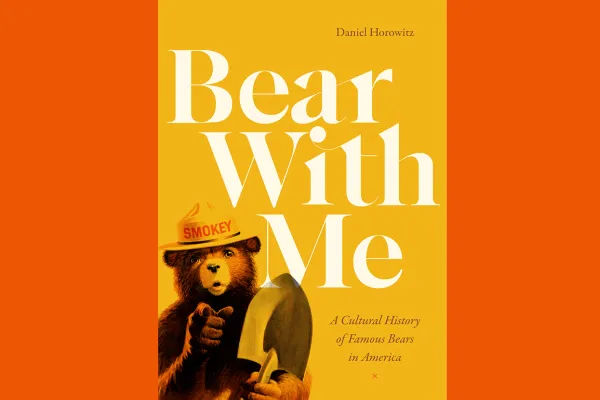When Scholarship and School Spirit Collide
Smith Quarterly
The author of a book about bears weighs in on Smith’s new mascot
In his most recent book, Horowitz explores how bears are “here, there, and everywhere.”
Published November 17, 2025
If my memory serves me well, in the 1950s there was in our house a yellow stuffed kangaroo with a baby in its pouch—Smith College’s mascot at the time. I like to joke that my mother, Miriam Botwinik Horowitz ’33, gave her only son to Smith, where—along with my wife, Helen Lefkowitz Horowitz—I taught for almost 25 years beginning in 1988. We both explored Smith’s history, she in Alma Mater: Design and Experience in the Women’s Colleges from Their Nineteenth-Century Beginnings to the 1930s (1984) and me in Betty Friedan and the Making of “The Feminine Mystique” (1988).
In my most recent book, Bear With Me: A Cultural History of Famous Bears in America (Duke University Press, 2025), I explore how bears are here, there, and everywhere—in the Bible, in the heavens, in folklore, in children’s stories, in advertisements for Charmin toilet paper, until recently in circuses, and still in the wild and in suburban backyards. Since the mid-1980s, there have also been gay bears—hefty, hairy men who every July gather by the thousands in Provincetown, Massachusetts, for Bear Week.
I discovered how shifts in media—especially the eventual arrival of powerful engines of popular culture—turned bears into celebrities. That trajectory began with oral traditions and stories in local newspapers, gained momentum with P.T. Barnum in the mid-19th century, and in the last 80 years has been amplified by Disney productions, cable television, and the internet, which have given enormous visibility to mostly imaginary bears. At the same time, stories of vicious bears reminded us that not all bears are cuddly—as in the novel and film The Revenant and Werner Herzog’s documentary Grizzly Man.
We continually anthropomorphize bears—projecting onto them a wide range of emotions and characteristics. Indeed, what is striking is how emotionally variable they can be. We read of some ferocious ones—though fewer than we might think—that kill innocent people. In contrast, bears entertained us by dancing or riding bicycles before they disappeared from circuses. And our parents read us stories of loving, nonthreatening bears and placed teddy bears beside us in bed. There is Winnie-the-Pooh, Paddington, the Berenstain Bears, Brother Bear or Brer in the Uncle Remus stories, Baloo from The Jungle Book, Pooky in the Garfield cartoon, and of course Papa Bear, Mama Bear, and Baby Bear, into whose house Goldilocks entered.
Into this wilderness comes the new Smith College bear, described in an official announcement as a symbol that reflects the college’s values and fierce competitive spirit. “Senda the Bear” honors Senda Berenson, a women’s basketball pioneer at Smith and nationally.
Smith is hardly alone in adopting a bear as its mascot. Bears have served as mascots for hundreds of high school, college, and professional sports teams, though few are as intriguing or emblematic as those involved in the intrastate rivalry between the Bears of the University of California, Berkeley, and the Bruins of UCLA. Over time, potentially ferocious grizzlies at both universities became less threatening, serving as prominent symbols of athletic prowess. Surely former Smith President Carol Christ cheered Oski, Cal’s bear, when she served as Berkeley’s chancellor. Most bear mascots are black, brown, or grizzly, but what do they become when portrayed on the field as costumed characters, with people inside bear suits? In the end, a bear is often an abstraction, far removed from the life of the actual animal.
Living away from campus since I retired more than a dozen years ago, I had no part in the decision to adopt Senda the Bear as Smith’s new mascot. I was surprised and delighted that my book on bears was published just as the college replaced the kangaroo of my childhood with a bear. It underscored what I discovered while writing the book: If some high schools, colleges, and professional teams embraced dangerous grizzlies, Smith made a different choice—one that was neither a cuddly teddy bear nor a truly ferocious bear, but a mascot with an appropriately fierce competitive spirit.
Daniel Horowitz, Mary Huggins Gamble Professor Emeritus and professor emeritus in American studies, is a historian whose work focuses on the history of consumer culture and social criticism in the United States. His book Bear With Me: A Cultural History of Famous Bears in America was published by Duke University Press in August, and On Retirement: How Aging Is Transforming American Lives will appear from NYU Press in March 2026.
